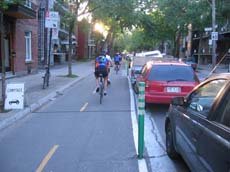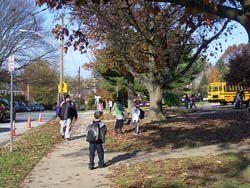Dedicated Bicycle Lanes/Tracks
Bicycle lanes are narrow lanes (1.2m to 1.5m wide) on the carriageway reserved exclusively for bicycles. They provide only partial segregation from vehicular traffic. Sometimes, the width of the bicycle lane is paved with a different material or painted to have a different colour than the vehicular lanes.
 The key advantage of bicycle lanes is that they are inexpensive to implement – they require only a line or two parallel lines to be painted along an existing roadway. However, their main disadvantage is that in the absence of a physical barrier between these and the vehicular lanes, they are prone to being encroached upon by motorists. It has been observed that bicycle lanes make motorists more aware of cyclists. All major North American cities have dedicated bicycle lanes within the transportation infrastructure network and are marked and published as exclusive pedestrian walking trails and bicycle lane maps by the respective local authorities respectively.
The key advantage of bicycle lanes is that they are inexpensive to implement – they require only a line or two parallel lines to be painted along an existing roadway. However, their main disadvantage is that in the absence of a physical barrier between these and the vehicular lanes, they are prone to being encroached upon by motorists. It has been observed that bicycle lanes make motorists more aware of cyclists. All major North American cities have dedicated bicycle lanes within the transportation infrastructure network and are marked and published as exclusive pedestrian walking trails and bicycle lane maps by the respective local authorities respectively.
Bicycle tracks, unlike bicycle lanes, segregate the cyclists from motorists through the use of strong physical barriers like a concrete median or a row of bollards. These tracks are sometimes equipped with dedicated signals at intersections. Montreal is the only municipality to have used this type of bicycle infrastructure extensively — its 3.5km long Claire-Morissette bicycle track through downtown was completed by the end of 2007 at a cost of $3.5 million.
Public Bicycle Sharing and Hiring Programmes
Inspired by European initiatives, public bicycle sharing and hiring programmes have been introduced successfully by metropolitan areas like Montreal, Boston, Minneapolis, and Washington, D.C in North America while many other large cities are planning to offer similar services with City of Ottawa and City of Toronto all set to start them in May 2011. These bike sharing and rental programmes are being operated through Public-Private Partnership (PPP) to encourage bicycle use within the downtown cores with provisions of parking locations near major points of interest/attraction, at residential neighbourhoods, near shopping centres and at university/college campuses.
Context Sensitive Solutions (CSS) for Walking and Biking Communities
 In the past 10-12 years, USDOT, in collaboration with American Association of State Highway and Transportation Officials (AASHTO) and the Federal Highway Administration (FHWA), jointly sponsored new initiatives that allow transportation planning and project development to consider overall surrounding texture of the respected locations by transforming major urban streets into more open and pedestrian/bicycle friendly space with compact and mixed land-use developments. The CSS multimodal planning approach helped many cities and communities in the United States and Canada to ensure that the needs of pedestrians and bicycle users are addressed in the early stages of planning itself to improve the overall environment for pedestrians and bicycle users, the safety of pedestrians/bicycle users using the facility, and better connectivity to other pedestrian/bicycle trail facilities. CSS, with its focus on design context, ensures reduction in potential vehicle-pedestrian/bicycle conflicts resulting in fewer accidents.
In the past 10-12 years, USDOT, in collaboration with American Association of State Highway and Transportation Officials (AASHTO) and the Federal Highway Administration (FHWA), jointly sponsored new initiatives that allow transportation planning and project development to consider overall surrounding texture of the respected locations by transforming major urban streets into more open and pedestrian/bicycle friendly space with compact and mixed land-use developments. The CSS multimodal planning approach helped many cities and communities in the United States and Canada to ensure that the needs of pedestrians and bicycle users are addressed in the early stages of planning itself to improve the overall environment for pedestrians and bicycle users, the safety of pedestrians/bicycle users using the facility, and better connectivity to other pedestrian/bicycle trail facilities. CSS, with its focus on design context, ensures reduction in potential vehicle-pedestrian/bicycle conflicts resulting in fewer accidents.
Bicycle Safety Strategies
The pedestrians’ and bicycle users’ safety improvements depend on an integrated approach that involves the 6Es: Engineering, Enforcement, Education, Environmental Impacts, Encouragement and Emergency Services.
 The Toronto Bicycle Plan commits the city to delivering stable funding for bicycle safety programmes. Under the plan, the city has to continue delivering and improving access to standardised CAN-BIKE safety training courses developed by the Canadian Cycling Association. The plan proposes that the city reviews its cycling collision and fatality data and determines education, enforcement, and infrastructure priorities accordingly. A related proposal is the development of educational materials to assist the cyclists involved in collisions. The plan also envisions expanding the Toronto Police Service’s role in bicycle safety. It proposes increasing the number of bicycle patrol officers across the city, devising traffic enforcement priorities together with the police service, and having a representative of the police service on the city’s Bicycle Safety Staff Team.
The Toronto Bicycle Plan commits the city to delivering stable funding for bicycle safety programmes. Under the plan, the city has to continue delivering and improving access to standardised CAN-BIKE safety training courses developed by the Canadian Cycling Association. The plan proposes that the city reviews its cycling collision and fatality data and determines education, enforcement, and infrastructure priorities accordingly. A related proposal is the development of educational materials to assist the cyclists involved in collisions. The plan also envisions expanding the Toronto Police Service’s role in bicycle safety. It proposes increasing the number of bicycle patrol officers across the city, devising traffic enforcement priorities together with the police service, and having a representative of the police service on the city’s Bicycle Safety Staff Team.
In the United States, various bicycle safety strategies are in place to reduce the number of bicyclist fatalities. They are: Reduction of motor vehicle speed in urban and suburban areas; reduction of distracted driving by motorists and distracted riding by bicyclists; education of motorists about ways of sharing the road with bicyclists; education of bicyclists on ways of riding in traffic and the use of proper equipment; and reduction of conflicts by Intersection Design Improvements.
Few other suggested activities in support of the above discussed bicycle safety strategies are:
• Maintaining bicycle facilities and shared roadways – Proper maintenance of bicycle facilities and shared roadways where frequent bicycling is a necessity.
• Embracing the Complete Streets Concept – Complete Streets has been a rapidly growing movement and is predicated on the notion of making streets friendlier for all users, including motorists, bicyclists, pedestrians, and users of transit.
• Continuing to fund Safe Routes To School (SRTS) initiatives – The SRTS programmes are continuing to grow. Funding should be continued to support the efforts to make it safe for children to bicycle or walk to school.
• Safety Applications for Persons with Disabilities as Road Users – The safety of persons with disabilities is dependent on the design of sidewalks and street crossings for usability. One of the significant applications under CSS is the installation of Integrated Accessible Pedestrian Signals (APS) and Push-Buttons in cities like Atlanta, GA; Charlotte, NC; Portland, OR; and Newton, MA for people with disabilities. APS features include speech WALK indication, pushbutton locator tone, pushbutton information message and automatic volume adjustment in response to ambient sound.
 Sadiq A Pirani, Principal Engineer ITS
Traffic Engineering and Transportation Planning
FOCUS Corporation, Canada
Sadiq A Pirani, Principal Engineer ITS
Traffic Engineering and Transportation Planning
FOCUS Corporation, Canada
 TrafficInfraTech Magazine Linking People Places & Progress
TrafficInfraTech Magazine Linking People Places & Progress